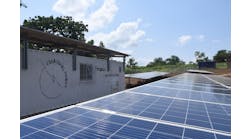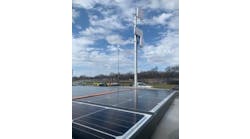The Village of Wappingers Falls is in an area of New York known for its spiritual retreat centers. Now two of those centers may expand their spiritual shelter to physical shelter by way of a community microgrid.
Located on the banks of the Hudson River, the densely populated village is vulnerable to flooding in storms. During Hurricane Irene, for example, the village experienced 49 incidents of flooding.
The floods threaten regional public service facilities, such as a water treatment plant. Electrical pumps help reduce the flood impact. However, in the event of a power loss, the village has little chance of beating back the flood waters that threaten many of its 5,600 residents, their property, and their public services.
So the village has proposed a $17.2 million community microgrid that would allow the Franciscan Mount Alvernia Retreat Center and neighboring Monastery of St. Clare to act as community shelters during a power outage. The Franciscan retreat center’s namesake, Christian Saint Francis of Assisi (circa 1200), is credited with the phrase, “A single sunbeam is enough to drive away many shadows,” which takes on new meaning here with installation of a 1 MW solar photovoltaic system as part of the microgrid.
Along with the emergency shelters, the microgrid would power critical services during extended electrical outages in this predominantly low to moderate income community. The microgrid’s footprint would encompass a water treatment facility, an inter-municipal wastewater treatment plant, two firehouses, two schools, about 1,500 residents as well as commercial and industrial customers.
The community microgrid would be powered by a mix of distributed energy resources, including:
▶▶$1.8 million for upgrade and repair the 2.45 MW hydroelectric facility to a total capacity of 2.7 MW
▶▶The new 1 MW photovoltaic array, supplied by SolarCity, at the Mt. Alvernia Retreat Center will complement an existing 0.2 MW solar array at the water treatment plant
▶▶A new 2 MW natural gas generator, available for use in demand response programs for an estimated 500 hours per year
▶▶Four existing diesel back-up generators at critical facilities
▶▶New battery systems by Eos Energy Storage with a total capacity of 1.25 MW
A 250 kW/1,000 kWh battery storage system will be installed by Eos Energy Storage as part of an award from the New York State Energy and Research Development Authority (NYSERDA). The batteries would provide ride through capability, voltage support, black start, and other ancillary services such as frequency regulation and on-site emergency supply. As part of its plan, Wappingers Falls wants to attract a battery company into its revitalized industrial park as a job provider.
The microgrid controls, governing systems, and power conversion equipment would allow both grid-connected and island modes of operation. In islanded mode the microgrid would have sufficient capacity to maintain service to all customers.
Community net metering (CNM) energy sales that originate from the microgrid’s renewable power plants (hydro and solar) may provide a partial means of capitalizing the project.
In a CNM model, a microgrid entity (legal structure to be determined) would market the CNM commodity as per the tariff from the local utility, Central Hudson Gas & Electric. The microgrid entity also would take responsibility for the obligation to serve load in an emergency, that is, when the microgrid islands from the central grid.
The CNM commodity would originate from authorized renewable electric energy supply resources (the existing hydro plant, new and existing PV plant). The increased revenue made available due to the price arbitrage (difference between wholesale electric supply prices at approximately 6 cents per kWh) in part will support the costs and profitability of the microgrid.
The project won $100,000 for a feasibility study through the NY Prize, a state-sponsored competition to incentivize grid-connected microgrids. It is now seeking financing to take the project to its next step. The village partnered with the town of Poughkeepsie and the Tri-Municipal Sewer Commission to initiate the proposal.
The project partners are the Village of Wappingers Falls, KC Engineering, Genesys Engineering, and Central Hudson Gas & Electric.
The source of this information is the NY Prize Feasibility Studies, NYSERDA and NY Prize Stage 1 Winner.
Learn more about community microgrids. Download the free Microgrid Knowledge report: “Community Microgrids: A Guide City Leaders Seeking Clean, Reliable and Locally Controlled Energy.”






